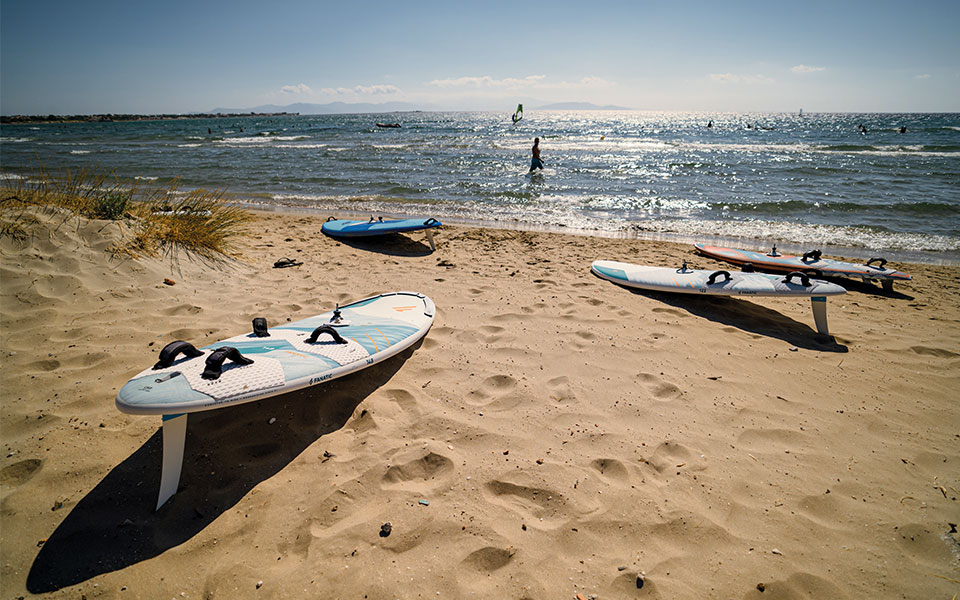Rule number one: look where the wind is coming from and turn your back to the wind. “Where is the wind coming from today?” asks instructor Tony Frey and we burst into laughter. With a north wind of Beaufort force 8, even if you know nothing about winds, instinct speaks. Fortunately, we are out of the water, stepping on the sand and for the time being at least, we are not in danger of being blown away. The experienced windsurfers are already in the sea and Tony and her assistants are watching them with binoculars. The instruction she gives to everyone is to choose a small sail and not to go more than a kilometer away.
“How dangerous is windsurfing?” I wonder out loud. “It’s not dangerous but it can become dangerous. It’s a very technical sport; even carrying the equipment needs to be done in a certain way. Anything you do is easy as long as you know the proper technique, from the correct way to carry the gear to how much you will trim the rope or how much you will tighten the boom. Otherwise, danger arises, for example, in very strong wind, in which case the joints might break and you could crash. The same applies if you run into fishermen’s buoys while having developed a high speed,” says the instructor.
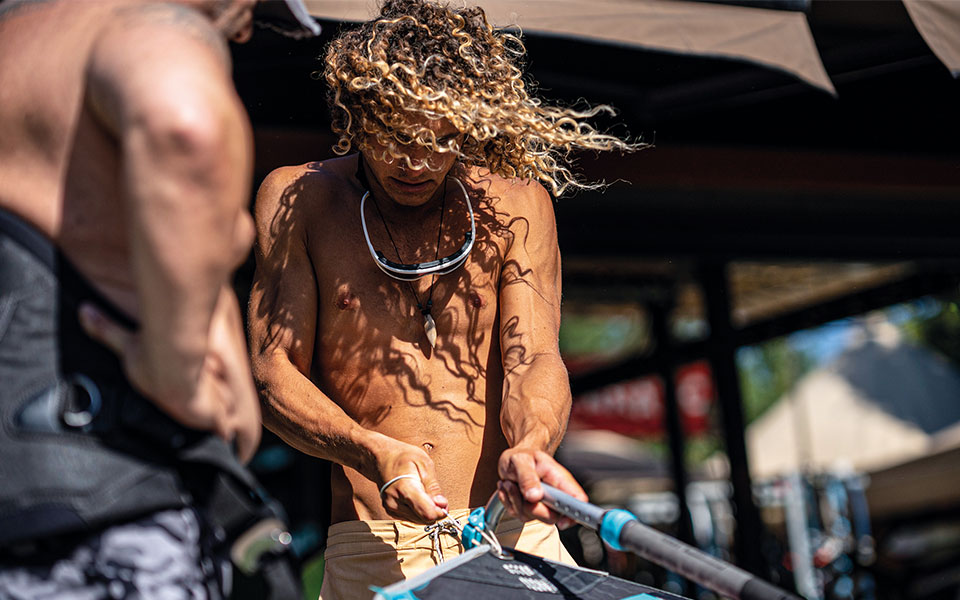
© Nikos Karanikolas
As she informs us, it is possible to slalom windsurf even at 40km/h. Slalom is a category of windsurfing and is essentially all about developing high speed. There is also the ride, which includes air tricks, the freestyle, the wave, etc. As we are still newbies, those categories are not for us yet. So we start with the basics: where to step, how to position our body on the board, how to hold the boom, and how to always keep the sail upright.
Just balancing appears quite hard, as does following the sequence of movements that we have to perform. At first we have to think before acting while later, everything happens spontaneously, almost mechanically. “The front foot faces forward as well as your pelvis; it’s like having six eyes looking forward. You must see the sail as a door and the mast as the hinge. The hinge always stays upright and doesn’t move and you just open and close the door depending on how much air you want your sail to get and where you want to go. There is no left and right, only front and back, that is bow and stern,” explains her assistant, Aris.
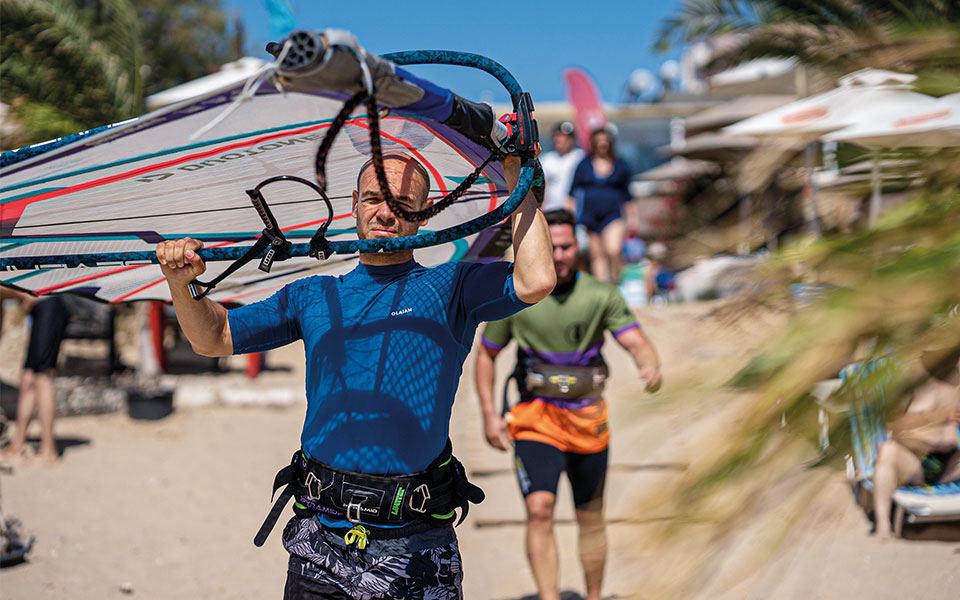
© Nikos Karanikolas
One Passionate Teacher
The truth is that even on shore it’s difficult at first to tune in, balance and switch quickly. Tony gets in the water, swims for a few meters and makes everything seem like a breeze. As she told us later, she basically taught herself how to windsurf. She used to travel abroad and observe other athletes. Her passion for training, sports and adrenaline helped her move forward.
“It’s all about progression, otherwise you get bored. In windsurfing there is always something to learn, this never ends. I was into slalom racing because I liked the speed – I didn’t even know how to turn when I took part in my first race. I lived on the beach for two months washing dishes in a bistro for a living. It was through my travels that I learned how to windsurf. In South Africa, I didn’t even have a means of transport. I worked as a waitress and other times in the fields and I used to hitchhike to get around. But I also found people who helped me and made my life easier. Later οn, sponsors started getting interested in me, because I had won two world championships by… mistake. I participated in a Wave race in Portugal. The champion at the time couldn’t pass the waves, so I won the first place. The reason I succeeded was because for me, who had no idea about racing, it was more about survival at the time. That’s how I got the championship. I didn’t have any specific goals, just to surf,” she confides.
Then came the first place in the Freestyle World Championship, afterwards her qualification for the Athens and Beijing Olympic Games, the third place in Europe and also in the world ranking… Her words make us eager to get in the water too, we trust her blindly. After all, in such sports, the instructor becomes your best friend.
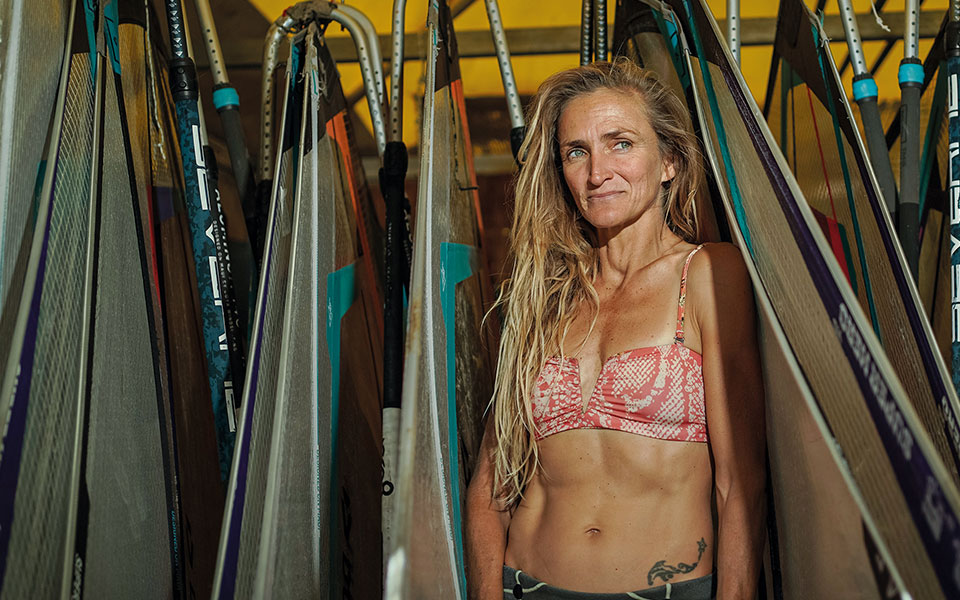
© Nikos Karanikolas
“The equipment that the instructor will give you is also important but the truth is that if you don’t spend lots of hours in the water training, you won’t progress. As an instructor I am constantly giving new goals to my students, even when they have completed their training. We are all members of a group here. That is to say the 20-30% of people who continue windsurfing after completing their training course.”
The hour of truth is approaching. The wind has fortunately died down a little. Kneeling on the board, I pull the uphaul and stand up, balancing like a counterweight. I pull the sail and immediately fall awkwardly. Nevertheless, the beginning is easier than I thought. I quickly manage to go a few meters in the water. The feeling is indescribable. The power of the wind, which inflates the sail and pushes me is exciting.
The sail pulls me, I pull it back – a unique battle or partnership. I feel its intensity being transferred throughout my body and the mighty wind takes me on a journey over the water. Before I could get enough, of course, I fell. The process was repeated countless times, without fatigue or boredom. Each time, one more step – it’s not easy, but it’s not impossible either. I feel like I could easily fight with the sail and the wind for hours.
“Windsurfing takes a lot of love and stability. And you should treat it like a lifestyle. Otherwise, how can you be in the water from morning to evening, under the sun, in a swimsuit?” Tony says. “That’s easy,” I answer, “at least while it’s still summer.”
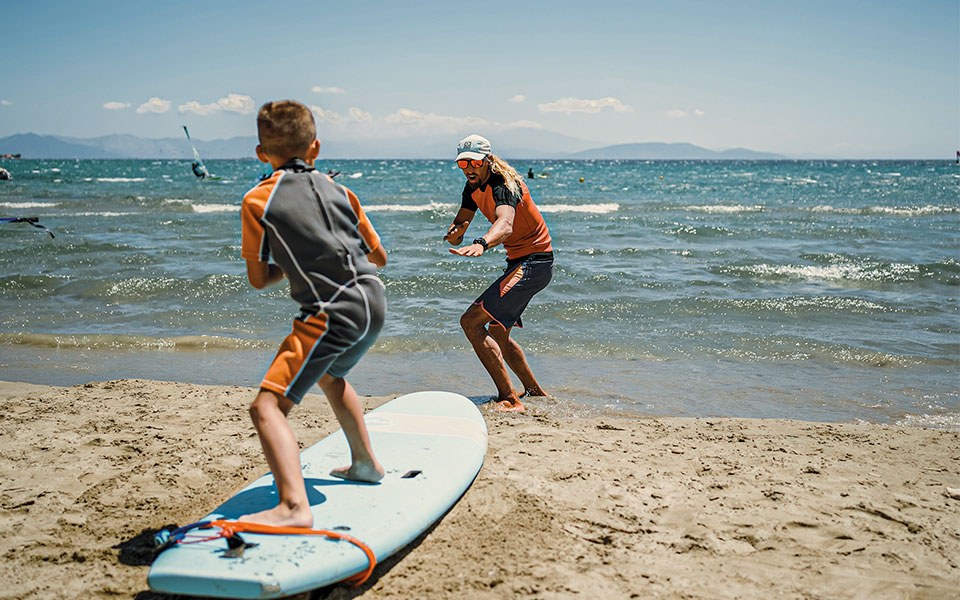
© Nikos Karanikolas
What You Should Keep In Mind
Easy access from your home must be a priority when you choose a school in order to save time, money and avoid inconsistent attendance. Conditions are also an important factor for beginners: in Varkiza the wind blows off shore (from land to sea, which is considered more difficult for a beginner), in Artemida, side shore (from the side), in Schinias, side shore to off shore.
Choose the equipment strictly according to your instructor’s directions. But keep in mind that it’s not recommended for beginners to purchase the required equipment, as their level and therefore the board size changes very quickly.
Wear a wetsuit to stay longer in the water without getting cold.
Windsurfing does not require a special physical condition, however extra pounds make sailing difficult.
The main advice given by the instructors is to always be aware of your location so that you don’t get carried away by the excitement and find yourself sailing in deep waters.
When falling, always protect your head with your hands, as you may not be aware of the exact position of the sail at the time.

© Nikos Karanikolas
Vocabulary For Beginners
Uphaul: a rope tied to the boom.
Boom: a bar that allows the windsurfer to control the sail.
Upwind: sailing towards the direction the wind is coming from.
Beam reach: sailing at 90 degrees to the wind direction.
Downwind: sailing towards the direction the wind is going.
Bear away: sailing towards the direction the wind is going, i.e. downwind
Tack: change of course while the surfer moves to the other side of the board.

